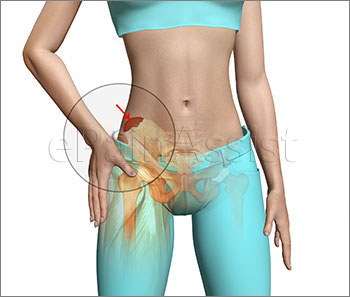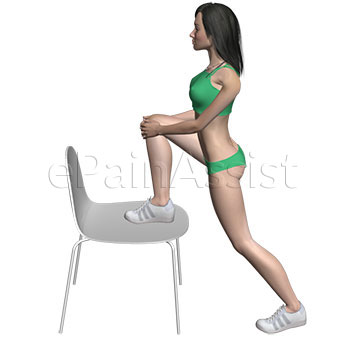This Article Discusses About:
What is a Hip Pointer Injury?
The pelvic cavity lies below the lower abdomen. Pelvic cavity is covered by pelvic bone in front and side. The posterior part of pelvic cavity is covered by sacrum. Pelvic bone is form by ilium, ischium and pubis. The ilium is also known as hip bone. Hip bone is flat and forms lateral wall of pelvic cavity. The most prominent uppermost and anterior (front) bony prominence of hip bone is known as iliac crest. Several muscles including the abdominal muscles are attached to the iliac crest. The blunt or sharp trauma to iliac crest is known as hip pointer injury or iliac crest contusion. Thus, hip pointer injury or iliac crest contusion is a condition of bruise that occurs at the upper part of the hip. 1,2
Hip Pointer Injury also includes soft tissue trauma and results in moderate to severe pain.

Causes and Risk Factors for Hip Pointer or Iliac Crest Contusion
Hip Pointer or Iliac Crest Contusion is an injury that results from a direct impact to the hip bone (iliac crest) as well as greater trochanter. Greater trochanter is the bony protrusion of femur and lies on upper lateral side. Hip pointer is a common injury observed in athletes who are participating in contact sports like american football, rugby and wrestling. The direct impact of iliac crest cause by object travelling at high velocity can cause avulsion fracture of iliac crest that results in hip pointer injury. Such injury is observed in athletes participating in baseball, cricket as well as work accident. The avulsion fracture of iliac crest is a displaced fracture since fracture part of bone is pulled away by the connected muscle. This region is specifically at risk since iliac crest lies directly under the skin and not protected by adipose tissue (body fat). The trauma blunt or penetration by sharp object also causes soft tissue injury, bleeding and swelling of muscles and subcutaneous tissue.
Some of the causes of hip pointer injuries or Iliac crest injuries are:-
- Sport Injury
- Motor bike Injury
- Automobile Injury
- Work Injury
- Domestic fall

Signs and Symptoms of Hip Pointer Injury
- Pain- Patient experiences severe pain immediately following hip pointer injury. Pain is localized over the area of injury. Pain following hip pointer injury becomes continuous and increases in intensity with increase of activities.
- Bruising and Hematoma- Immediately following the accident the skin become purple and tender. The purple bruise slowly spreads in size, which suggest possible subcutaneous spread of bleeding. Later, in few hours if bleeding continues then blood clot forms that also enhances the pain and restricts movements.
- Swelling – Swelling is observed because of tissue edema and hematoma. Tissue edema is more predominant over side of iliac crest and gluteal muscles. Hematoma over iliac crest causes soft tissue swelling under the bruises.
- Tenderness- Palpation and examination of injured area elicits severe pain. Deep pressure causes prolonged severe pain. The condition is known as tenderness.
- Muscle Spasms– Muscle spasm is often seen within the surrounding muscles. Most of the muscle spasm is observed in gluteal muscles and anterior thigh muscles.
- Reduced Range of Motion- Pain and soft tissue swelling restricts the affected leg movement like flexion and rotation. Movement is also restricted because of separation of tendon that is attached to iliac crest.

Lab Studies-
Blood Examination- Complete blood count is performed to check blood hemoglobin, red blood cell count and white blood cells count. If the bleeding is profuse and hematoma is large the hemoglobin concentration and red blood cell count will be low suggesting patient is anemic and may need treatment to improve anemia. The white blood cell count is always normal and may change to higher level later if blood clot as well as inflamed injured muscle and bone gets infected. If white blood cell count is higher then patient is treated with antibiotics.
- X-Ray– X-ray examination is performed to rule out fracture of iliac crest.
- CT Scan– Like X-Ray, Ct scan will show presence of fracture of iliac crest. CT scan also shows internal spread of hematoma.
- Ultrasound examination- Ultrasound examination will show the depth and spread of hematoma and injuries. The blood clot and tissue swelling can be identified by ultrasound examination.
Treatment of Hip Pointer Injury
- Rest- Avoid all activities that aggravate the symptoms of hip pointer injury or iliac crest ijury.
- Cold Therapy for Pain- Cold therapy is beneficial if provided immediately after the hip pointer injury to prevent bleeding and spread of hematoma.
- NSAIDs– Non-Steroidal anti-inflammatory medications such as Ibuprofen, Aspirin, Celebrex and Naproxen are helpful to treat tissue inflammation and pain. The healing of the injury is faster when NSAIDs are taken during initial phase of injury. Avoid self medication. Take NSAIDS only if prescribed by physician.
- Corticosteroid injections- Corticosteroid injection is contraindicated if the wound is infected. Corticosteroid injection is helpful to treat inflammation, tissue swelling and assist rapid wound healing. Corticosteroid also reduces the pain.
- Sports massage– Massage therapy is indicated to reduce swelling, prevent scar tissue formation and loosen up the muscle fibers in hip pointer injury.
- Aspiration Of Blood Clot- If large blood clot is observed then clot size is reduced by aspiration of the liquid part of the clot. The decrease in size helps to reduce the pain.
- Surgical Treatment- Surgical treatment is necessary if hip pointer injury is associated with fracture of hip bone. The fragment of displaced fracture is realigned at original position and fixed to the hip bone by either passing nail or wire.
Best Hip Pointer Exercises
Exercise would accelerate healing of the contusion and also prevent muscle atrophy. Exercises recommended are non-weight bearing graded exercise or the graded exercise as described below. Graded exercises strengthen and stabilizes the muscles acting on the hip joint.4
-
Standing Hip Pointer Stretch Exercise

This hip pointer exercise is performed in standing position. Patient will stand in front of chair and rest normal leg over the chair. Next patient attempts to stretched affected leg by sliding the affected leg backward.
-
Wall Hip Pointer Stretch Exercise

This hip pointer exercise is performed by standing perpendicular to a wall by keeping the affected hip away from the wall. Place the hand of the healthy side on the wall. Stretch the upper body away from the wall, while hand firmly kept on the wall. Raised the injured leg and stretched forward maintaining unaffected leg firmly on the ground. Raised the injured leg about 6 to 12 inch from the ground and stretched it in front. The body is stretched to form a “C” shape curve. Relax the affected leg and rest it on ground.
Repeat the exercise and stretched the leg again in front of body holding foot 6 to 12 inch above the ground. Hold the position for at least 30 seconds and rest. Repeat the exercise 5 times daily.
-
Kneeling Hip Pointer Stretch Exercise

This exercise is performed by keeping the knee of the affected hip on the ground and healthy leg in the front side by keeping the foot flat on the ground. Tighten the muscles of stomach to flatten the lumbar spine and gradually move the upper body so as to support the weight of the body by the front foot. Keep on moving in forward direction until a pain-free stretch is felt in the hip and groin area. At the same time by reaching the head with the arm of an unaffected side smoothly pull the upper body away from the affected side. Hold the position for about 30 seconds.
Hip Pointer Recovery Time
Hip Pointer is not a career ending injury. The hip pointer injury or iliac crest injury may take several days or weeks to heal. The recovery is always complete and satisfactory. The non-fracture hip pointer injury heals in 4 to 6 weeks. Hip pointer injury associated with iliac crest fracture may take 6 to 12 weeks to heal completely. Displaced fracture may need surgical treatment and recovery then prolongs to 8 weeks or longer.
-
Hip pointers.
Hall M1, Anderson J., Clin Sports Med. 2013 Apr;32(2):325-30.
-
The “hip-pointer”, a term to describe a specific kind of athletic injury.
Blazina ME., Calif Med. 1967 Jun;106(6):450.
-
Bracing treatment for chronic avulsion of the iliac crest apophysis.
Tompkins M1, Ehrlich M.
Clin J Sport Med. 2010 Mar;20(2):122-4.
-
Avulsion fracture of the anterior superior iliac spine in a collegiate distance runner.
Draper DO1, Dustman AJ., Arch Phys Med Rehabil. 1992 Sep;73(9):881-2.
Also Read:
- Hip Bursitis or Trochanteric Bursitis: Causes, Symptoms, Treatment, Exercises
- Hip Dislocation: Types, Causes, Signs, Symptoms, Treatment, Exercises, Tests
- Hip Flexor Strain: Types, Causes, Symptoms, Treatment. Exercise, Recovery
- Hip Sprain: Causes, Symptoms, Treatment, Exercises
- Hip Tendonitis: Causes, Symptoms, Treatment, Exercise, Prevention
- Labral Tear of the Hip Joint
- Snapping Hip or Dancers Hip: Treatment, Exercise, What Can Cause Your Hips to Snap?
- Hip-Opening Yoga Poses & Its Benefits, Precautions
